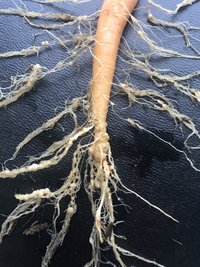Researchers compile and review literature on plant chemical impacts on nematodes
Certain nematodes can cause great damage to crops and yields, and they can be difficult to control. Researchers from the Department of Agroecology at Aarhus University have compiled and reviewed the literature to gain a better understanding of the nematodes and find more effective control possibilities.

Nematodes are small roundworms that live in the soil. There are many different kinds, some are beneficial and others are harmful to plants. The beneficial nematodes help decompose dead plants and animals in the soil, and kill certain plant-pathogenic insects. However, there are also types of nematodes that feed on plant roots, and they cause major problems worldwide, where they can cause up to 10 percent of all crop loss.
"There are very few pesticides worldwide that can fight the harmful nematodes, and the few that do exist are banned in the EU because they are harmful to humans, animals and the environment," says researcher Mette Vestergård Madsen from the Department of Agroecology, Aarhus University. “However, natural plant-produced chemicals may be useful as alternative measures against plant pathogenic nematodes,” she continues.
Together with her colleague and PhD student Md Maniruzzaman Sikder, she has delved into the secret world of plant chemical impacts on nematodes to compile the literature that already exist within the field.
An aid to other researchers
So far, the knowledge that exists about nematodes and their responses to different plant chemicals has been widely scattered, and that is what the two scientists set out to change.
“We wanted to compile the knowledge to increase our own understanding of the nematodes. And maybe it can help other researchers as well,” says Mette Vestergård Madsen.
In the review of the literature, the researchers focused on how chemicals from plants can reduce the damage caused by the harmful nematodes.
“We examined what is already known about the effects of natural chemicals on the harmful nematodes. And then we discovered that there is a lack of knowledge about how the beneficial nematodes are affected. It is often overlooked and it may cause new problems,” says Md Maniruzzaman Sikder. He believes more research need to be done to explore this.
Plants as protection
All plants release chemical substances into the surrounding soil, and some of the substances can be used to control the harmful nematodes.
“It could be interesting to investigate the possibilities of genetic plant breeding, to increase plant content of the chemical substances that the nematodes do not like. That way the plants will be able to protect themselves,” says Md Maniruzzaman Sikder.
In the literature, there is already some knowledge about what happens in the soil and which chemical substances work. However, according to the researchers, this knowledge is not used very much. They highlight an example with potato production, which experiences heavy losses and restrictions due to nematodes.
“Potato cyst nematodes are a major problem for potato growers. They simply live off eating the roots of the potatoes, and we know that they can be latent in the soil for many years, only to be brought back to life when potatoes come back into the soil,” says Md Maniruzzaman Sikder.
A very specific chemical is needed for the nematode eggs to hatch and the small worms develop. A chemical that the potato plant itself releases.
“But we know that some relatives of the potato plant release the same chemical and at the same time these plants are resistant to the nematode. We will in other words be able to use these plants to hatch the eggs earlier than usual so that there are no potato roots for them to eat. They will simply starve. That is a way to get rid of them, but it's not very used,” says Mette Vestergård Madsen.
Hope for more and broader research in the field
The researchers hope that their work will give rise to new and exciting research in the field. For example, most of the research done so far is done in laboratories. And according to the researchers, there is a long way from a petri dish to an actual field.
“You will almost always see an effect when you add a chemical to an organism in a petri dish, but it is something completely different when it has to take place in the field. Here, soil type plays a role, as do other types of microorganisms,” says Md Maniruzzaman Sikder.
According to the researchers, both laboratory and field experiments are needed.
"On the whole, there is a lot more research to be done, but we believe that it is now easier for both us and other researchers to find the right direction for our future research," says Mette Vestergård Madsen.
Behind the research
- Affiliates: None
- Funding: Funded by a grant from Aarhus University and Aarhus University Research Foundation
- Conflicts of interest: None
- The publication: ”Impacts of Root Metabolites on Soil Nematodes” is published in Frontiers in Plant Science 31 January 2020. It is written by Md Maniruzzaman Sikder and Mette Vestergård Madsen.
For further information contact
PhD student Md Maniruzzaman Sikder, Department of Agroecology, Aarhus University. Email: mms@agro.au.dk. Tel.: +4571653031
Researcher Mette Vestergård Madsen, Department of Agroecology, Aarhus University. Email: mvestergaard@agro.au.dk. Tel.: +45 8715 8121
